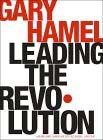In many superb articles and books on management practices, Gary Hamel has, more than any other scholar, developed the concept that organizations have core competencies which can be identified and then used to an organization’s competitive advantage. His writings have always had a feeling of gravitas, with a strong element of scholarliness that one would expect from a management professor. His new book, however is profoundly different. Leading the Revolution reads more like a Tom Peters book, by way of New York personality/chef Emeril Lagasse: “BAM! Blow up the old ways and INNOVATE, INNOVATE, INNOVATE!” The book is a mix of font styles, exclamatory sentences, and, yes, a few helpful insights along the way. But not as many as we might like. To prepare us for what lies ahead, he articulates his objective: “This is a book about innovation – not in the usual sense of new products and new technologies, but in the sense of radical new business models.” Our appetites whetted, our blood pumping, we steam ahead, eager for a glimpse of the future. But then he disappoints us by turning prosaic: “We’ve reached the end of incrementalism, and only those companies that are capable of creating industry revolutions will prosper in the new economy.” Yes, but we’ve known that for quite some time. Hamel’s message, creatively displayed as it is in a multitude of typefaces and colors, too often falls flat. Hamel leaves the paprika to Emeril but tries to add his own spice: “Boom! You’re irrelevant!” he warns us, if we fail to innovate. But we must do more than innovate, we must “embrace the new innovation agenda.” And embracing that agenda means nothing less than challenging “every management tenet you inherited from the age of progress.” This is, of course, nothing new. In 1982 Peter Drucker wrote in the Frontiers of Management that “innovative companies assume that all existing products, services, procedures, and markets are becoming obsolete, and pretty fast at that….The innovative company organizes itself to abandon the old, the obsolete, the no longer productive; it prefers to abandon obsolete products itself rather than have them made obsolete by the competition.” Irish Management philosopher Charles Handy added his voice for discontinuous thinking in his book The Age of Unreason, published in 1989, and Stanford professors James Collins and Jerry Porras focused on how visionary companies constantly innovate in their solid book Built to Last in 1994. The path that Hamel has gone down in this book is well worn. The problem is, of course, that in far too many companies the pattern continues to be “BAM!” a new idea is born somewhere down in the bowels of the company. Then somewhere along the line, long before implementation, someone higher up says, “We’ve never done it that way before. BAM! Forget it.” This is where Hamel’s book is most helpful. He is highly critical of the way most organizations are managed. The way we manage and lead organizations of all kinds, but especially large organizations, urgently needs innovation and re-invention. Hamel is especially critical of CEOs: “There is nothing on this earth with a shorter time horizon than a 60-year-old CEO with a boatload of stock options who’s racing his first coronary to the bank.” Innovation, he tells us, is about the farthest thing from that CEO’s mind. Not rocking the boat, managing Wall Street’s expectations, and “enhancing shareholder value” are the three most important items on most CEO’s daily to-do lists. “Most management processes are controlled by the defenders of the past”, Hamel writes. We know this, we write about it, we know we must change such practices, but yet we do not. Why? Because we find ourselves locked in a vicious circle: The practices that must be changed are protected by the most intractable managers. Innovation ends up, therefore, as nothing more than incremental improvements in production and brand extensions in the marketplace. Those who most need this book are those who are least likely to read it. Those who are already innovating will no doubt embrace Hamel’s ideas, eager for a jolt of cerebral caffeine. This restless army of revolutionary men and women never sit still, and are never satisfied. They constantly seek new ways to do things that are radically different, new products and services that no one else has even considered. This is innovation at its best. Hamel sees the need for even more revolutionaries in the corporate world. Seeking incremental improvement is not enough for Hamel; instead, he wants his army of revolutionaries to turn organizations on their heads. This takes courage, especially in the typically stolid, plodding organization where the CEO’s idea of enhancing shareholder value is a massive stock re-purchasing program. It takes revolutionary thinking to change this type of organization, and Hamel’s book is the cri de coeur. Hamel want revolutionaries to infiltrate somnolent organizations and has given his army a handbook for guerrilla warfare. His is a noble and worthy goal, even if his book often seems inflated and pompous. Now, the only question remains, when are management writers such as Hamel going to find a more innovative and revolutionary way to communicate their messages than through a medium that is 600 years old, expensive, and ponderous?
Looking for more insights?
Sign up to stay informed about our latest article releases.



